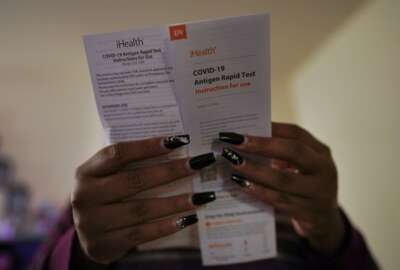Defense Logistics Agency keeps supply of at-home COVID tests flowing
The Postal Service is the public face for the government's efforts to supply Americans with at-home COVID tests. But behind the scenes, the Defense Department i...
Best listening experience is on Chrome, Firefox or Safari. Subscribe to Federal Drive’s daily audio interviews on Apple Podcasts or PodcastOne.
The Postal Service is probably the biggest public face for the government’s efforts to supply Americans with at-home COVID tests. But behind the scenes, it’s actually the Defense Department that’s doing a lot of the heavy lifting, specifically the Defense Logistics Agency. The agency’s DLA Distribution arm has been in charge of storing and moving those test kits to their final destinations and tracking the supplies all the way through the process. To talk more about DoD’s role, the Federal Drive with Tom Temin spoke to four guests from DLA Distribution: Commander Maj. Gen. Keith Reventlow, Deputy Commander Perry Knight; Col. Todd Walker, the director for current operations; and Steven Forster, the supply management specialist.
Interview transcript:
Jared Serbu: Whoever wants to take it first, I want to talk about some of the nuts and bolts of the logistics and tracking mechanisms that you’ve put in place for this mission. But could you just give us a sense of what DLA’s role in the COVID-19 test mission actually is? Because I think the Postal Service is really most people’s main interface with this whole program that’s serving Americans.
Todd Walker: Hey, sir, this is Col. Todd Walker. Our role with this was really to provide the Department of Defense strategic accountability of assets based on the president’s 1 billion test kits distributed out to the American people. And DLA provides that response of taking accountability from cradle to grave of this mission, sir.
Jared Serbu: And when you say “cradle to grave,” can you walk us through a little more what that entails, what the start and end points really are?
Todd Walker: When it comes to cradle to grave, our intent here at DLA Distribution is to transship all materials. So to ensure that we get this to the American people as fast as possible, DLA, at two primary sites received material, and we received the material in accountability of assets, and then had trucks ready to take those assets and transmit them directly to the United States Postal Service.
Jared Serbu: Got it, that makes sense. Was it obvious to you at the very outset that you were going to also need to track everything cradle to grave and not just move everything cradle to grave? And how difficult was that to integrate with your partners here?
Steven Forster: So, Steve Forster here. There’s a lot of different components that we had to get in place as far as understanding the amount in different types of volumes that were coming in to our different distribution centers for that. And it was just a really large working conversation between the different stakeholders to understand not only what data was available, what the expectation of the data was, and then how we integrate that together into a platform that can answer all the questions.
Jared Serbu: And from DLA leadership’s point of view how has that gone so far? What can we say about how well it has worked?
Keith Reventlow: So this is Maj. Gen. Reventlow. I would say it has worked phenomenally, I mean, we essentially got this mission in the middle of January, we started turned and executed on it within just a couple of weeks. Something we are very familiar with doing cross dock operations, but this is one that obviously nobody had done before. So it was a great opportunity for us to go out and execute this. I think it went very, very well. I mean, we hit the, initially was the 500 million test requirement that the president had levied. We got halfway into that, I think by mid-February, and today, things have slowed down quite a bit. We’re right around 533 million test kits of the now 1 billion test kit requirement. But I think the team responded in a way that they always do, which is to meet the mission. And really, I would say for the most part, it’s been error free.
Jared Serbu: And what was some of the uniqueness of this mission? DLA obviously used to working with other components of the Defense Department and with other private sector logistics providers, probably don’t work with the Postal Service or HHS every day. That strikes me is one potential difference here.
Perry Knight: Well, I think that you captured the unique piece of it. We work with the whole of government. During the pandemic, it was fairly commonplace to work with Health and Human Services. In this particular instance, it was the first time that we’ve worked with the Postal Service. And in particular, delivering to post offices, one on the East Coast eventually became a transition to it, second, and then one on the West Coast as well.
Jared Serbu: So tell me a little bit about the technology capabilities that you built into this to actually provide visibility, not just you, I think, but to your other partners over all of these movements.
Steven Forster: So we were able to integrate in a lot of different lessons learned from reporting on KPIs and really taking a step into operationalize the information from the data that we had to ensure that we had 100% transparency between what we were doing with the data we were sharing with the external stakeholders. But inside of the application itself, not only were we able to develop metrics and scale them to where we only had to ingest the data to then update them. So it was pretty much a hands off effort at that point. But we’re also able to bring in some of the geo analytic capabilities, which allowed leadership to see the material movement visually across the entire country from where it shows up the different distribution centers, the transportation lines going to the individualized USPS locations and other locations throughout the country where that’s something that’s a little bit new for DLA, as far as leveraging a modern business intelligence application in this fashion. But it really helps to tell the story of the complete operation and the breadth and reach it had across the whole country.
Jared Serbu: And was this application something that you purpose built for this particular function? Or were you building up some other projects that DLA already had in the pipeline?
Steven Forster: Yeah so – Steve here – we’ve actually been developing click applications for about four years now at distribution headquarters, where this mission was one that, when it came to us was something that we’re like, OK, this is something we can definitely leverage because of all the lessons that we’ve learned across time. And from the initial receipt of material, it took only 14 days for the data collection validation standardization to take place and develop a large enough data set to where we can start developing the working models for the application where that whole development time for this application only took 11 days where it went live and launched on Feb. 8, and it has been living in that state, with some other alterations and adjustments to it promoting the agile development lifecycle where we’re building off of what we have to meet our needs, as they grow across time.
Jared Serbu: Once you start talking about moving data across agency boundaries, strikes me that that’s where a lot of projects run into trouble. Seems like you pretty successfully managed to plug into USPS data systems and HHS data systems without too much trouble here. How did that all work?
Steven Forster: So we were able to bring the information together since we were the collecting agent for it, to gather and curate everything and then share that with the whole government partners to HHS, where we were providing the information to them for what was happening at our distribution centers to fill in the leg between from what was originating to manufactures being cross docked through our operation, and then deliver it to the USPS facilities, where they were then capturing the metric for the delivery to the customers. And our counterparts with Tiberius system were very helpful and open with us as far as discussing any concerns they may have had with the data to where we can then make the adjustments to what we were capturing and how we were sending it, to make sure that their process was as lean as possible.
Jared Serbu: That’s great. Open it up to everybody else to just ask whether it’s from an IT standpoint, or from a logistics standpoint more broadly. Any lessons learned from this project that you’re gonna carry forward?
Steven Forster: Yeah, Steve here. One of the biggest lessons that we’ve been able to learn from this whole project is the full open line of communication between both internal and external stakeholders inside of the agency for ensuring that we have the discussions at the beginning for what their expectation is for the data and the frequency of delivery, as well as what senior leadership’s expectations are for the metrics. So that way, they’re provided the information that they need to make critical decisions and have active discussions about the mission without requiring any access talking points or further clarification from the people working the mission. We wanted to make sure that they were able to open the application, not get confused, have the information at their fingertips and run with it from the date the application was actually published.
Todd Walker: It’s Col. Walker. I would say this was an ITV for us, right? We needed to make sure we had accountability of these assets that the click app provided our senior leaders that opportunity to have that and so we were able to follow up with our government partners. So we truly had our hand on this pulse from the time we began.
Copyright © 2024 Federal News Network. All rights reserved. This website is not intended for users located within the European Economic Area.
Tom Temin is host of the Federal Drive and has been providing insight on federal technology and management issues for more than 30 years.
Follow @tteminWFED







